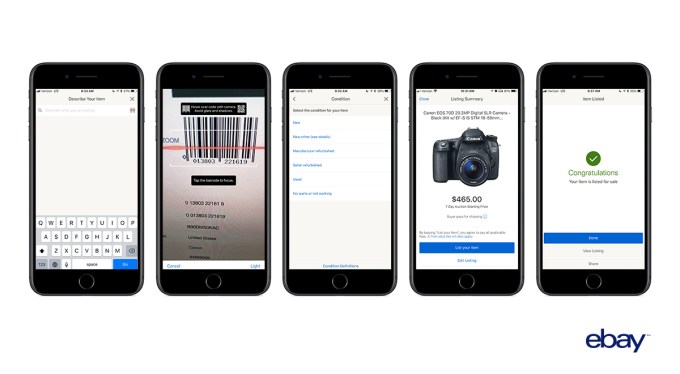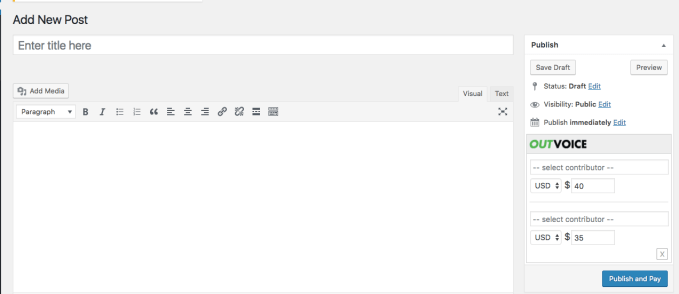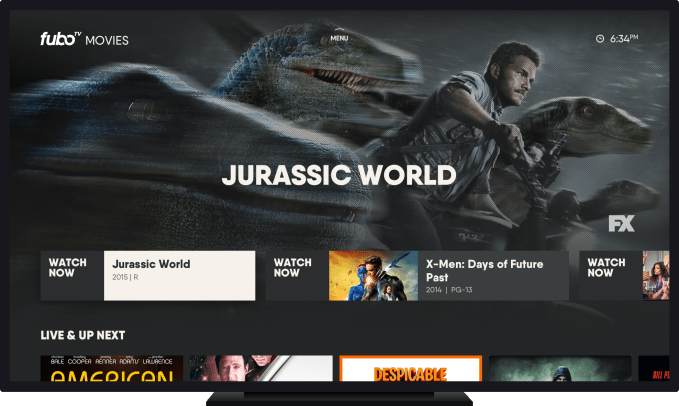Ebay is rolling out an app update designed to make it easier to list items for sale on its online marketplace. Instead of filling out detailed forms on your mobile phone’s small screen, you can now scan the barcode on the item in question or type a description, choose the item’s condition, then click “list your item” to make the listing go live on eBay’s site.
After scanning or entering the description, eBay’s app will do a one-to-one match to its catalog to help to fill in the necessary information for that product. It will also offer sellers a pre-populated stock photo, eBay’s price recommendation and its shipping recommendations,
The change is meant to reduce to a matter of seconds the number of steps it takes to list. And if the process is less cumbersome, eBay hopes more people will choose to sell on eBay as opposed to the growing number of resale apps like OfferUp or LetGo, which are currently ranking higher than eBay on Apple’s App Store.
Facebook’s Marketplace has also likely had some impact on eBay’s sales, especially in terms of local sales.
Despite the increased competition, eBay is still seeing more than 13.4 million listings added to its site every week from the eBay mobile app alone.
The app’s newfound ability to quickly list the item uses technology like structured data and predictive analytics to pre-populate listings with the information required, instead of relying on sellers to type it in themselves.

This use of technology is something the company believes is a competitive advantage over newcomers to the space, in addition to its ability to provide access to millions of shoppers around the world.
“At eBay, we’re dedicated to delivering a seamless and efficient selling experience for both first-time and seasoned sellers alike,” says Kelly Vincent, eBay’s VP of Consumer Selling Product & Engineering, in a statement about the app’s revamp.
“This latest update continues to leverage eBay’s structured data, which helps catalogue the 1.1+ billion items on the platform, to instantaneously populate product details, pricing and shipping information in the listing flow. Not only does the catalogue facilitate a superior listing experience, it enables buyers to easily find the great deals offered by our sellers,” she added.
Vincent also noted that eBay’s use of structured data and other new technology will make its way to other products and features this year, but didn’t say what those may be. However, the focus for now seems to be enabling sellers.
Ebay’s updated app with the barcode scanning feature for listings is rolling out now on both iOS and Android.
Powered by WPeMatico




 And an ALS medication currently in development — which Mulvaney says will aim to significantly extend the prospects for those who have been diagnosed with ALS — is about five years away from trials. It’s worth the effort to try, though: The best ALS medications on the market today at best only add about three months to a patient’s life expectancy.
And an ALS medication currently in development — which Mulvaney says will aim to significantly extend the prospects for those who have been diagnosed with ALS — is about five years away from trials. It’s worth the effort to try, though: The best ALS medications on the market today at best only add about three months to a patient’s life expectancy.

 Presumably a large portion of that will be video processing and compression hardware, since they’ll want to minimize bandwidth and latency but don’t want to skimp on quality. Efficiency is important, too; satellites have extremely limited power, so running multiple off-the-shelf GPUs with standard compression methods probably isn’t a good idea. Real-time, continuous video from orbit (as opposed to near-real-time stills or clips) is as much a software problem as it is hardware.
Presumably a large portion of that will be video processing and compression hardware, since they’ll want to minimize bandwidth and latency but don’t want to skimp on quality. Efficiency is important, too; satellites have extremely limited power, so running multiple off-the-shelf GPUs with standard compression methods probably isn’t a good idea. Real-time, continuous video from orbit (as opposed to near-real-time stills or clips) is as much a software problem as it is hardware.

